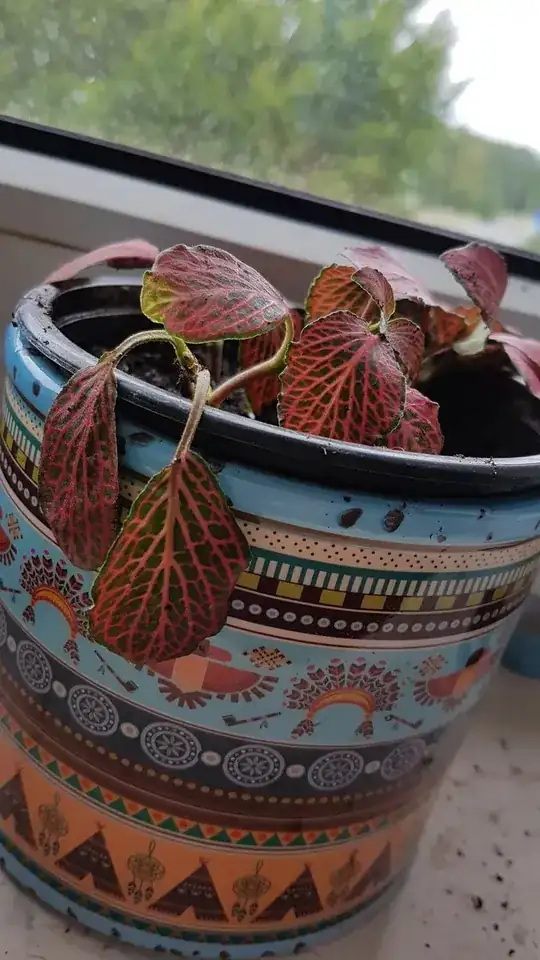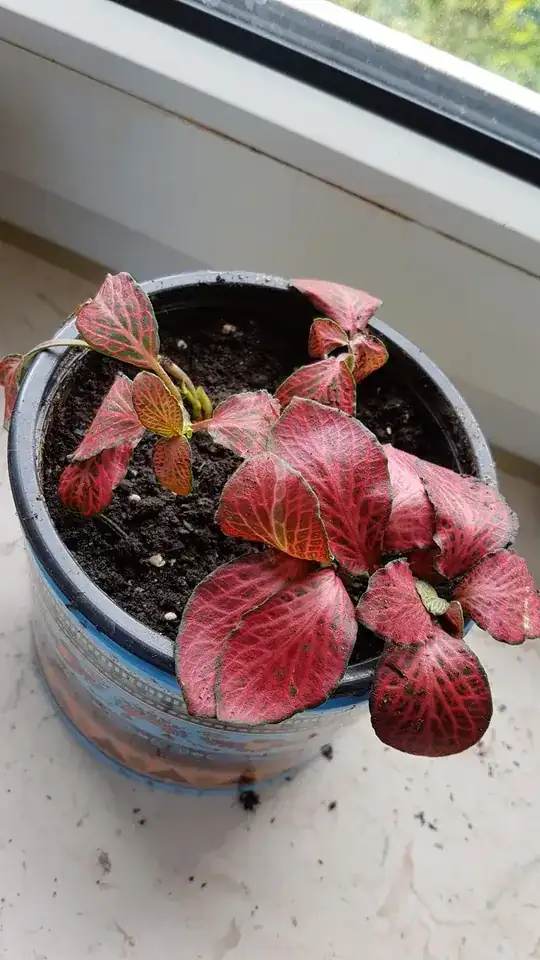Your plant is overwatered. Too much soil for the tiny amount of root system to be able to suck up the water before rot can happen. Does this pot have a hole at the bottom? The ceramic pot? Probably not which is where the water sits and stagnates and the soil will stay wet. Roots are rotting and your plant doesn't have enough healthy roots to uptake water thus it is 'wilting'.
I would take it out of the pot gently, get rid of that soggy soil and replace your plant in fresh potting soil. No garden soil. No compost. Potting soil should have no gimmicks such as water holding gels/sponges or even any added fertilizer. Boring plain, sterilized soil.
Get another pot. A 4" diameter that is no more than 3 or 4 inches in height. Drain hole. Lift bottom of pot off saucer with pieces of 1/4" tiles so that that pot is never sitting in water. Clay is great for pots. They even make clay pot feet in eagle or lion claws...bunnies. The tile pieces are cheaper.
Feel the heft of your pot after transplanting and after slightly watering the soil. Don't soak at this point. Water shallowly when that pot feels lighter. You'll be able to tell. Plenty of light but do not put out of doors nor in direct sunlight unless this plant is used to direct sun through the kitchen window. Right after planting keep this plant out of direct sunlight or high heat.
I'd use 3 little pots you have 3 little plants, right? and transplant now so there is no chance of too much wet, soggy soil and thus loss of more roots. Use Osmocote 14-14-14 extended release all purpose fertilizer. Wait for a week before adding fert. I rarely fertilize my indoor plants more than once per year with any fertilizer. Low light means low but not no fertilizer. Use half of the direction amount per pot (1 tsp?) If you want them all in one larger pot, get a 10" pot that is only 4" high and transplant maybe next year when your plants are healthy. Then add another teaspoon of Osmocote. This isn't my favorite fertilizer but it is bare basics for chemistry, extended release and lasts the plants up to half a year, indoors as well as outdoors. This is safe to use. Hard to mess up with Osmocote. Following the directions and making allowances for plants not able to do mass photosynthesizing, less chemistry.
Water only when those pots start feeling lighter. Stick a finger down into the soil a few inches. If you can feel moisture don't water. You don't want the soil to dry out too much. Do not put rocks or gravel below the soil to 'increase drainage' it does the exact opposite.
When you first transplant keep these plants out of direct sun and in a more cooler area to reduce transpiration. They might make it and again they might not. They have rotting roots and might be too far along.
Pot within a pot is never a good idea. Sitting water is the kiss of death for potted plants (unless you've got a semi-aquatic plant and even they don't like anaerobic conditions). When you transplant, heck you could tip that pot upside down gently holding the plant between your fingers as you hold the top of the soil and root ball. Can you smell sewer? If not then maybe the roots aren't so badly damaged. Get rid of that soggy soil and replace your plant on top of dry clean soil. Allow as much soil to drop from the root ball as possible and get rid of it. Do not get too wigged out about cleaning the roots, just allow chunks of soggy soil to drop off and then gently plant this plant in a small pot of dry, clean soil.
Soak your clay pots in warm soapy water for an hour. Rinse, then put JUST potting soil 1/3 to 1/2 full in your pot, firm! Firm is firmly pressing the soil down to get rid of large pore spaces. Not making concrete...? Place your plant in a depression in the soil. Cover the roots with more potting soil, firm gently, got to have good soil/root contact but your roots are already damaged so gently. Make sure you have at least one inch of space between the surface of the firmed soil and the rim.
I would also go as far as watering with distilled water not tap water. Clay pots show when salts become a problem. They get a white coating on the rim and sides as well as the top of the soil.
If these plants do not make it, you will be able to tell very quickly, I would not use that bit of soil again. Also, the pots should be sterilized with a bit of bleach. You are ready for the next experiment?

